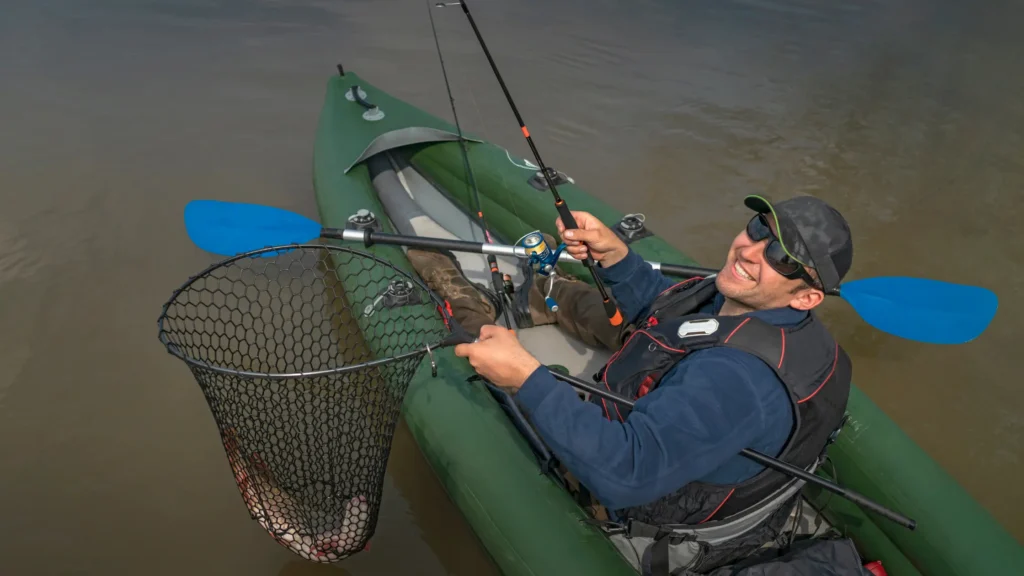
Are Inflatable Kayaks Good for Fishing? Yes, inflatable kayaks can be good for fishing. With attributes such as being lightweight, easy to afford, and maneuverable, inflatable kayaks serve as great alternatives for those seeking fun outdoor activities like fishing
Additionally, when compared to traditional hardshell kayaks in terms of stability and endurance capacity, among others, inflatable ones are often lacking. Choosing the ideal option requires that you consider your particular fishing needs and likes.
Table of Contents
The Case for Inflatable Kayaks
There are high chances that if you love spending your time angling in the water, then buying yourself a good fishing kayak has definitely been contemplated by you. The abundance of choices can make it challenging to select the ideal kayak for fishing purposes.
While it has been common to choose hardshell kayaks traditionally, inflatable counterparts have recently seen a rise in popularity.
Inflatable kayaks offer a number of advantages over their rigid counterparts. For one, they are incredibly portable and easy to transport. Unlike hardshell kayaks, which require expensive roof racks or trailers to transport, inflatable kayaks can simply be deflated and packed away in a compact carrying case.
In addition to their portability, inflatable kayaks are also highly durable and stable. Made from high-quality materials like PVC or nylon reinforced with polyester fibers, these kayaks can withstand harsh weather conditions and rough waters without getting punctured or damaged.
For those who enjoy fishing in tight spaces or shallow waters, inflatable kayaks are ideal due to their maneuverability and versatility. They can easily navigate through narrow channels or get into tight spots where larger boats would struggle to go.
The Drawbacks of Hardshell Kayaks
Traditional hardshell kayaks remain preferred over inflatable ones by some anglers despite the advantages that the latter offer. But why? The reason behind preferring the traditional hardshell kayaks is the presence of limitations in inflatable kayaks.
Lack of portability is one significant downside of hardshell kayaks. Moving around in town using means other than pick-up trucks fitted with bed extenders and cars hauling trailers proves challenging when transporting rigid kayaks. Even when you have successfully managed to transport your hardshell kayak, storing it could still pose more challenges.
When comparing hardshell against inflatable kayak types, it becomes clear that inflatables provide better comfort levels since staying still in fixed positions generated by solid designs gets tedious pretty easily, impacting areas like your rear or adipose tissue without any foam pads. Prolonged seating with inadequate cushioning puts stress on both the hips and back muscles, which leads to pain.
The Advantages of Inflatable Kayaks for Fishing
Portability and Ease of Transportation
One of the most significant advantages of inflatable kayaks for fishing is their portability and ease of transportation. Traditional hardshell kayaks require a considerable amount of storage space, which can be a challenge for those who live in small apartments or have limited storage areas.
Inflatable kayaks solve this problem by being incredibly compact when deflated, making them easy to store in closets, trunks, or even under beds. Another benefit is that they are ideal for those who travel frequently.
If you’re someone who loves going on fishing trips but hates the hassle of transporting equipment, then an inflatable kayak might be your new best friend. These kayaks can quickly be packed into a carrying case and taken on planes, buses, or even on backpacking trips without taking up too much space.
Durability and Stability
Many people may have concerns about whether inflatable kayaks can withstand harsh weather conditions or rough waters. However, these concerns are unfounded as high-quality materials are used in construction.
A durable kayak will typically feature multiple layers of puncture-resistant material to prevent any leaks or tears while navigating rough waters.
Furthermore, inflatable kayaks tend to be more stable than traditional hardshell kayaks precisely because they sit higher in the water due to their design. This increased buoyancy provides better stability when casting out lines and reeling in fish.
Versatility and Maneuverability
Inflatable kayaks’ versatility cannot be overstated, as they can navigate shallow rivers with ease due to their lightweight design. Their ability to move quietly through tight spaces makes them perfect for anglers looking to get up close with their prey without causing too much disturbance.
Their versatility extends beyond river fishing too. They are equally at home on calm lakes as they are on rough seas. The inflatable design allows for easy maneuverability, ensuring fishermen can navigate any water body with ease. Inflatable kayaks offer several advantages over traditional hardshell kayaks when it comes to fishing.
They’re incredibly portable and easy to transport, making them ideal for frequent travelers or those with limited storage space. They’re also durable and stable thanks to the high-quality materials used in their construction.
Their versatility and maneuverability make them perfect for anglers who want to explore a variety of fishing spots. If you’re looking for a new fishing experience or want to upgrade your current equipment, an inflatable kayak might be worth considering.
Features to Look for in an Inflatable Kayak for Fishing
Material Quality and Thickness
The quality of the material used in the construction of the inflatable kayak is one of the most important features to consider while buying. The material should be durable enough to withstand punctures, scrapes, and scratches.
A quality inflatable kayak made with puncture-resistant materials can save you from unnecessary expenses in repairs or replacements.
When it comes to inflatable kayaks for fishing, investing in a good quality kayak is essential as it will have to endure rough waters and potential hazards such as sharp rocks, hooks, or fish fins. High-quality materials such as PVC or Hypalon are ideal choices for inflatable kayaks meant for fishing due to their durability and resistance to punctures.
Proper Thickness Ensures Durability in Water
Apart from the material quality, thickness also plays an essential role in ensuring durability in water. Thick materials provide better stability against external factors that could damage your kayak’s exterior layer.
A thick layer also prevents any accidental puncture that could occur while transporting, inflating, or deflating. When looking at thickness, it’s best to aim for a minimum of 0.9mm and above, which can withstand harsh weather conditions better than thinner layers.
Investing in high-quality materials with proper thickness will save you money spent on repairs and replacements in the long run.
Size And Weight Capacity
Choosing the right size is crucial when it comes to selecting an inflatable kayak meant for fishing purposes. The appropriate size depends on several factors, such as the user’s body type, water currents where kayaking takes place, and storage room availability during transportation, among others.
Inflatable kayaks come in various sizes ranging from small single-person units to larger ones that can accommodate two or more persons at the same time.
It’s essential to consider the size and how it affects stability, maneuverability, and overall performance. A kayak too small for an individual will be uncomfortable, while one too big can compromise the paddler’s control and stability.
Weight Capacity Should Be Adequate To Carry Gear, Fish, Etc.
In addition to size consideration, weight capacity is another crucial factor that needs attention while purchasing an inflatable kayak meant for fishing purposes. The weight capacity should be adequate to carry all your fishing gear, such as rods, baits, and tackle boxes, as well as any fish caught during your excursion.
It’s important to note that exceeding a kayak’s weight limit can affect its performance by reducing its buoyancy and speed on the water. A good rule of thumb is always to choose a kayak with a slightly higher weight capacity than what you require for optimal performance.
Fishing-Specific Features
Fishing-specific features are essential when it comes to selecting an inflatable kayak meant for fishing purposes. These features include rod holders, tackle storage space as well as any other accessory which could make your fishing experience much better. Rod holders are highly beneficial while kayaking in rough waters or when you need both hands free.
Tackle storage options provide easy access to all your needed equipment without having to search through bags during kayaking. Seating comfort is also essential in ensuring long hours spent kayaking remains enjoyable without getting tired from sitting uncomfortably throughout the trip.
Choosing the right inflatable kayak meant for fishing requires careful consideration of various factors such as material quality and thickness, appropriate size according to user’s needs, and adequate weight capacity.
Fishing-specific features such as rod holders and tackle storage space, among others, should also be taken into account when making a purchase decision. Investing in a high-quality inflatable kayak will save you the hassle of unnecessary repairs or replacements and provide an excellent platform for all your fishing adventures.
The Bottom Line
So, are inflatable kayaks good for fishing? The answer is yes – they offer a number of benefits that make them an excellent choice for anglers. They’re portable, durable, stable, and versatile, making them ideal for navigating tight spaces and shallow waters.
Ultimately, your choice will be based on which option meets your specific requirements and personal tastes. While there are pros and cons when choosing between inflatable verse traditional kayaking equipment for fishing purposes, the ultimate decision rests solely on the angler’s needs and preference.
